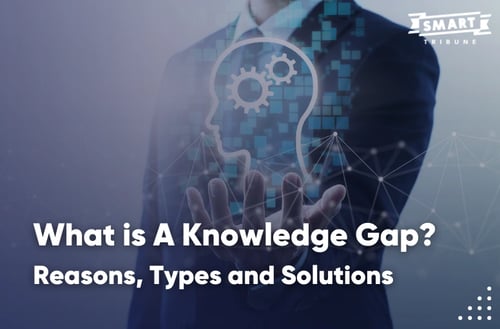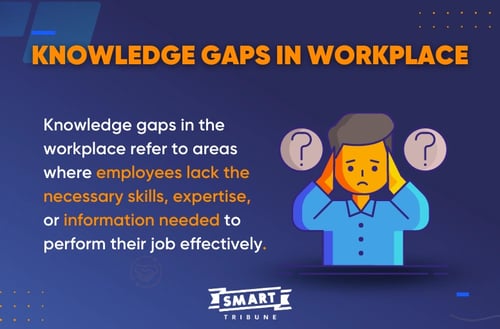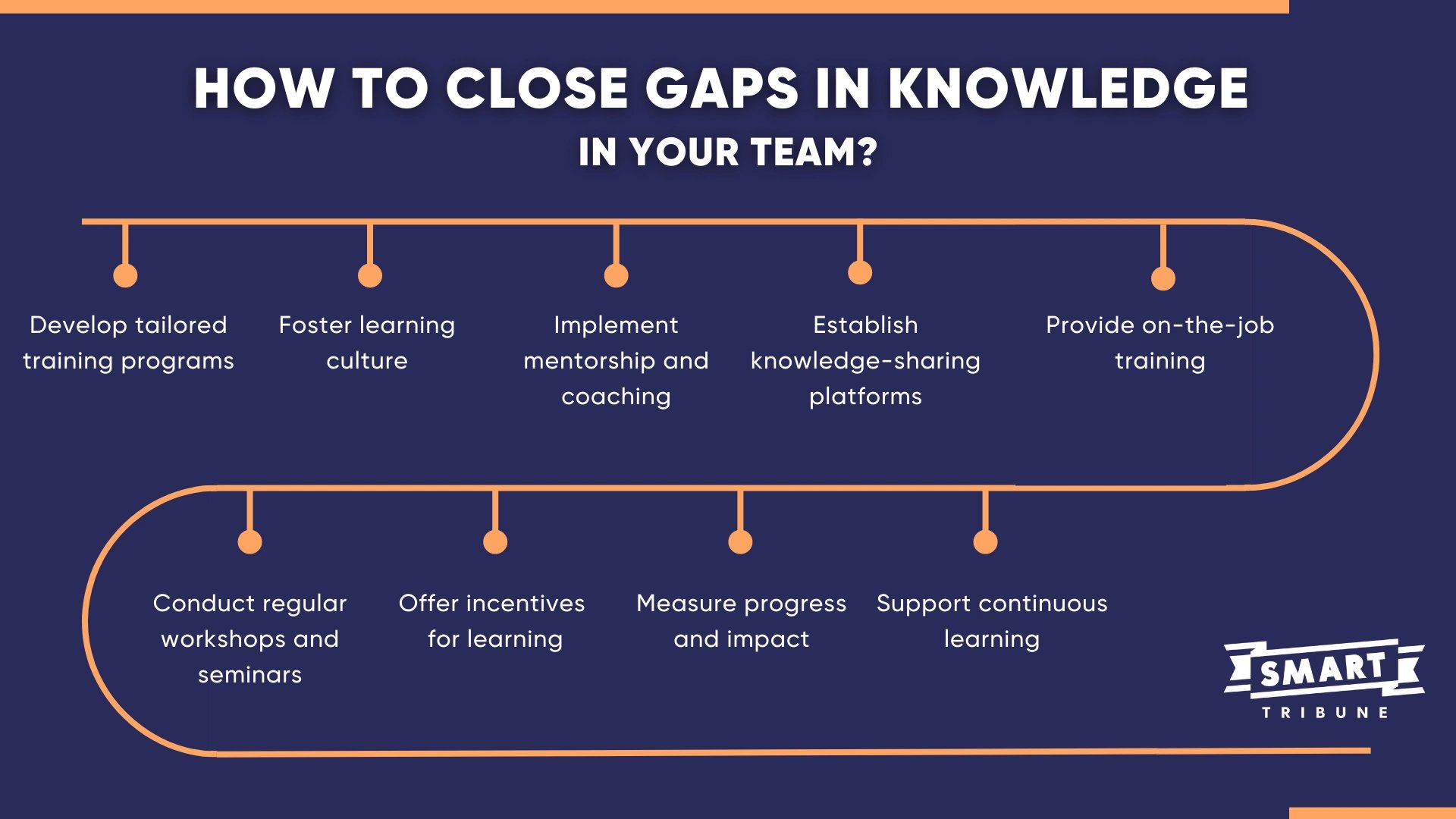
At the core of every thriving organization is a set of knowledge, skills and advanced technology. In some cases, employees may encounter knowledge gaps at the workplace, which directly intervene with their productivity time after time.
To help your business prevent systematic errors due to gaps of knowledge, in this article, Smart Tribune will be providing you with:
- Knowledge gap definition;
- Tactics to inspect knowledge gaps;
- Ways to deal with a knowledge gap;
- Causes of knowledge gaps in an organization;
- Types of gaps of knowledge;
- Frequently asked questions.
If you're eager to close the knowledge gaps immediately, let's get the ball rolling!

What are Knowledge Gaps in the Workplace?
Knowledge gaps in the workplace are widely known as areas where employees lack the necessary skills, expertise, or information needed to perform their job effectively.

Gaps in knowledge can hinder productivity, innovation, and overall success within an organization. That's why identifying and filling knowledge gaps is of paramount importance for improving employee performance and achieving business objectives.
How to Identify the Knowledge Gap in Your Organization?
Before looking for solutions for filling knowledge gaps in the workplace, employers, project managers or team leaders need to inspect the gaps in knowledge.
If you're not familiar with this task, here comes our step-by-step guide to spot even the microscopic cracks.

Conduct employee surveys
Team leaders or managers can distribute surveys to employees to gather feedback on their perceived strengths and weaknesses in their roles. Additionally, you can further inspect the gaps by proactively asking about the specific skills or knowledge that your employees feel they need to improve their performance.
In this stage, you are collecting valuable insights into potential knowledge gaps to perform the next step in a more effective manner.
Perform skills assessments
To perform skills evaluation, managers can hand out:
- Practical tests,
- Simulations,
- Written assessments.
The form of skills assessment or proficiency tests greatly depends on the nature of the job. These sorts of tests can help leaders evaluate employees' competencies in various areas.
Analyze performance reviews
In this step, you can review employee performance evaluations and feedback to identify patterns of strengths and weaknesses.
Leaders can easily look for recurring themes or areas where multiple employees may require additional training or support.
Monitor error and incident reports
Besides of aforementioned assessment and evaluation tests, leaders have to keep track of error reports, incidents, or customer complaints to list out common mistakes or issues in the team. These occurring problems can be regarded as knowledge gaps that need to be addressed.
Hold focus group discussions
Organizing focus group discussions with employees can encourage open conversations about their experiences and challenges in their roles. This activity enables leaders to uncover knowledge gaps and gain a deeper understanding of employees' perspectives.
Review training requests
Another channel where leaders can find out the gaps is to analyze the training requests or development plans submitted by employees. These requests can reveal their lack of expertise or knowledge.
Seek feedback from managers
Not only the board should try to figure out the knowledge gaps, but also the employees. They can be encouraged to consult with higher-leveled managers to gain insights into their performance.
Managers can provide valuable information about knowledge gaps and areas that require improvement.
Track industry trends and innovations
One of the factors that aid your business to steer clear of knowledge gaps and stay competitive is to update with industry trends, innovative technologies, and best practices.
By regularly checking and benchmarking information with your organization's current skill set, leaders can detect potential knowledge gaps that need to be sealed to adapt to ever-evolving technological advancement.
Analyze organizational goals
The ultimate goals of your business always serve as a tactical primer in any organizational activities.
When leaders or managers pay closer attention to the organization's strategic objectives and identify the skills and knowledge required to achieve them, they can compare these requirements with the existing capabilities of the workforce to point out the gaps that may hinder progress.
Benchmark with competitors
The key to the success of each business varies. However, managers can conduct benchmarking exercises to compare an organization's skill set with that of competitors to specify the areas where your organization might be falling behind in terms of knowledge and expertise.
By using a combination of the above methods, you can gain a comprehensive understanding of the knowledge gaps present in your workplace. Once you have identified the specific rooms of improvement, you can develop targeted training programs and initiatives to bridge those gaps and enhance overall employee performance and organizational effectiveness.
How to Close Gaps in Knowledge in Your Team?
Closing knowledge gaps in an organization is crucial for enhancing employee performance, fostering innovation, and achieving business goals. Let's zoom in a little closer to some effective strategies to close knowledge gaps in organizations.
Develop tailored training programs
Once you've performed the steps above to pinpoint the knowledge gaps, you should begin designing training programs that address those specific needs.
These programs can include workshops, seminars, online courses, and hands-on training. Don't forget to tailor the content and delivery methods to suit different learning styles and preferences.
Foster a learning culture
Despite the company and team size, leaders should consider creating an environment that encourages continuous learning and professional development. Leaders can encourage employees to take ownership of their learning journey and provide resources, such as access to online learning platforms, books, and workshops, to support their growth.
Implement mentorship and coaching
In the working environment, freshers are generally in need of support from seniors to quickly absorb expertise. To tackle that demand, leaders can pair employees with experienced mentors or coaches who can provide guidance, share knowledge, and offer insights to bridge the gaps. Mentorship programs help transfer tacit knowledge from experienced employees to newer ones.
Learn more about The basics of knowledge transfer and its crucial role in the normal operation of a business.
Establish knowledge-sharing platforms
Leaders can set up internal platforms, such as
These platforms and tools can encourage cross-departmental collaboration and knowledge exchange.
One of the juggernauts of the knowledge-sharing platform is Smart Knowledge developed by Smart Tribune. With Smart Knowledge, employees can share information, best practices, and lessons learned to boost efficiency and productivity.
Check out How to successfully develop an internal knowledge management strategy?
Provide on-the-job training
Leaders can always foster experiential learning by allowing employees to learn through real-life projects and challenges. On-the-job training helps employees apply theoretical knowledge in practical scenarios, reinforcing their learning.
Conduct regular workshops and seminars
Regular workshops, seminars, and webinars led by subject matter experts or industry leaders matter. These events can cover relevant topics and trends to keep employees up-to-date with the latest developments in their fields.
Offer incentives for learning
It is indisputable that a learning environment must be fostered. One of the techniques is to recognize and reward employees who actively engage in learning and closing knowledge gaps. Leaders can offer bonuses, promotions, or other incentives to motivate employees to invest in their professional development.
Measure progress and impact
Managers or any person in charge should utilize metrics like improved performance, increased productivity, and reduced errors to assess the impact of training programs.
Don't forget to check out How to develop a knowledge management framework that benefits your business!
Support continuous learning
Learning doesn't end with the closure of specific knowledge gaps. Managers and team leaders should motivate employees to continue learning and growing in their roles by offering opportunities for advanced training and upskilling.
Closing knowledge gaps is an ongoing process, and it requires commitment from both the organization and its employees. By implementing these strategies and fostering a culture of learning and development, your organization can stay agile, competitive, and well-equipped to adapt to changing circumstances and industry demands.
Reasons for Knowledge Gap
We have been through a long journey, but we haven't mentioned the roots of knowledge gaps. That's why in this part, we will be pointing out universal factors that contribute to knowledge gaps.
- Rapid technological advancements
- Lack of training and development
- High employee turnover
- Limited access to information
- Siloed work environments
- Unclear communication
- Changing job roles
- Cultural and language barriers
- Lack of learning culture
- External market changes
- Limited feedback and evaluation
- Resistance to change
- Overdependence on individual expertise
Why Should Organizations Fill Knowledge Gaps ASAP?
Filling knowledge gaps in organizations is essential for several compelling reasons that directly impact success, productivity, and competitiveness. Here come some of the key reasons why organizations should prioritize closing knowledge gaps:
- Improved employee performance: Closing knowledge gaps helps employees develop the necessary skills and expertise to perform their roles more effectively. This, in turn, leads to improved job performance, increased productivity, and better overall results for the organization. Businesses can enable performance tracking with a performance management tool to see the differences.
- Enhanced innovation: When employees have a broader knowledge base, they can think more critically, creatively, and innovatively. Filling knowledge gaps fosters a culture of continuous learning and encourages employees to explore new ideas and solutions.
- Higher employee satisfaction and engagement: Offering opportunities to bridge knowledge gaps through training and development demonstrates that the organization cares about employees' growth and well-being. This can lead to increased job satisfaction and higher levels of employee engagement.
- Better decision-making: Well-informed employees can make more accurate and data-driven decisions. Closing knowledge gaps ensures that decision-makers have access to the most up-to-date and relevant information, leading to better choices for the organization.
- Increased adaptability: In today's rapidly changing business landscape, organizations must be adaptable and flexible. Filling knowledge gaps helps employees stay current with industry trends, technological advancements, and best practices, making the organization more resilient to change.
- Reduced errors and risks: Knowledgeable employees are less likely to make mistakes or overlook critical details, reducing the potential for errors and associated risks in various aspects of the organization's operations.
- Better customer service: When employees possess in-depth knowledge about the products or services they offer, they can provide more precise information to customers, leading to improved customer satisfaction and loyalty.
- Talent retention and attraction: Organizations that invest in closing knowledge gaps signal to employees that they value their growth and development. This can help retain existing talent and attract skilled professionals seeking opportunities for continuous learning.
- Increased competitive advantage: Well-trained employees can give an organization a competitive edge. They can respond to market changes and challenges more effectively, positioning the organization as a leader in its industry.
- Succession planning: By addressing knowledge gaps, organizations can identify potential future leaders and ensure a smooth transition when experienced employees retire or leave the company.
- Compliance and risk management: Addressing knowledge gaps related to regulations and compliance ensures that employees understand and adhere to legal requirements, reducing the organization's exposure to legal and financial risks.
- Positive organizational culture: A learning-focused culture that prioritizes knowledge sharing and development fosters a positive work environment, leading to increased morale and collaboration among employees.
Apparently, closing knowledge gaps is a strategic investment that yields significant benefits for organizations. It empowers employees, enhances decision-making, and contributes to the overall growth and success of the organization in a rapidly changing and competitive world.
Common Types of Knowledge Gaps in Workplace
Gaps of knowledge in an organization are categorized into several groups:
.webp?width=500&height=330&name=Types%20of%20Knowledge%20Gaps%20in%20Workplace%20(1).webp)
- Technical knowledge gaps: These gaps occur when employees lack the required technical skills or expertise to use specific tools, software, or equipment essential for their job. It could include proficiency in programming languages, operating specialized machinery, or understanding complex software applications.
- Industry knowledge gaps: Employees may lack a deep understanding of the industry they work in, including knowledge of market trends, competitors, regulations, and best practices. Keeping up-to-date with industry developments is crucial for making informed decisions and staying competitive.
- Product or service knowledge gaps: Employees need to be well-versed in the products or services the company offers to effectively communicate with customers, address inquiries, and provide excellent customer support.
- Process knowledge gaps: Organizations often have specific processes or workflows that employees must follow to maintain consistency and efficiency. Knowledge gaps in these processes can lead to errors, delays, and inefficiencies.
- Soft skills knowledge gaps: Soft skills, such as communication, leadership, problem-solving, and teamwork, are essential for a harmonious and productive work environment. When employees lack these skills, it can lead to misunderstandings, conflicts, and decreased collaboration.
- Compliance and regulatory knowledge gaps: Employees must be aware of and adhere to relevant laws, regulations, and company policies. Knowledge gaps in this area can expose the organization to legal and financial risks.
- Organizational knowledge gaps: New employees or those transitioning to different roles may not possess a comprehensive understanding of the organization's culture, values, history, and internal processes. This can hinder their ability to integrate smoothly into the company.
- Knowledge transfer and succession planning gaps: In cases where experienced employees retire or leave the company, there may be a gap in transferring their knowledge to newer employees. Proper succession planning and knowledge transfer strategies are essential to mitigate these gaps.
All of these gaps in knowledge can result in low productivity, poor performance of employees, and eventually seriously interfere with overall business operations and growth.
FAQs about Knowledge Gaps in Business
What is a knowledge gap?
A knowledge gap refers to the lack of information or understanding in a particular area, highlighting what individuals or organizations do not know or comprehend.
What is knowledge gap theory?
Knowledge gap theory, also known as the knowledge gap hypothesis, posits that information dissemination through mass media tends to increase the gap of knowledge between those who have greater access to media and those who have less access. This difference results in an unequal distribution of knowledge and information in society.
What is the impact of knowledge gaps?
The impact of knowledge gaps can lead to misinformation, reduced productivity, missed opportunities, and hindered innovation, ultimately affecting individual and organizational growth and success.
Final Thoughts on Filling Knowledge Gaps and Skill Gaps
Running a business is not an easy task. Therefore, to ensure everything is on track, decision-makers should provide employees with the necessary information, expertise, and data to help them maximize their productivity, and close knowledge gaps and skill gaps.
To facilitate the process of filling the gaps in knowledge at the workplace, businesses can leverage knowledge-sharing platforms, such as Smart Knowledge to accelerate both employees and the business's growth.
Hope that this article has yielded you with the fundamentals of knowledge gaps in business. Should you have any questions regarding knowledge management, drop Smart Tribune a line for further assistance.

.png)



